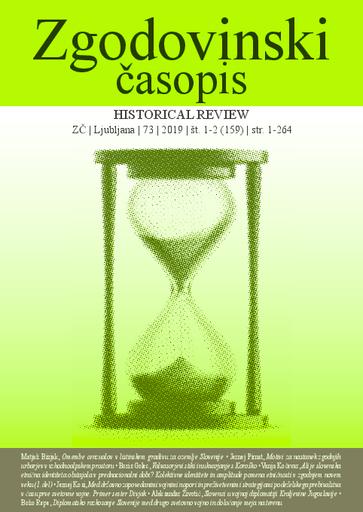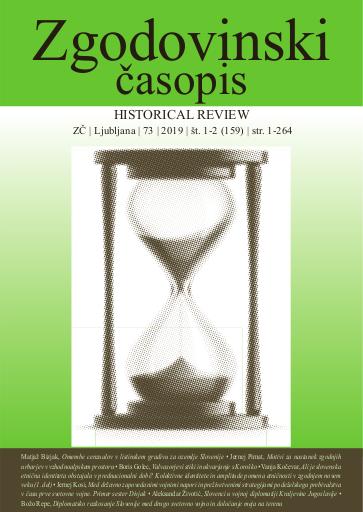/
Serijske publikacije
/
Zgodovinski časopis
Valvasorjevi stiki in ukvarjanje s Koroško

Avtor(ji):Boris Golec
Soavtor(ji):Peter Štih (odg. ur.), Saša Mlacović (prev.), Vesna Vidmar (drugo)
Leto:2019
Založnik(i):Zveza zgodovinskih društev Slovenije
Jezik(i):slovenščina, angleščina
Vrst(e) gradiva:besedilo
Ključne besede:Valvasor, Koroška, Albert Reichart, topografija, Št. Pavel v Labotski dolini, Justus van der, Valvasor, Carinthia, Albert Reichart, topography, Sankt Paul im Lavanttal, Justus van der Nypoort
Avtorske pravice:

To delo avtorja Boris Golec je ponujeno pod Creative Commons Priznanje avtorstva-Nekomercialno-Brez predelav 4.0 Mednarodna
Datoteke (1)

Ime:ZC_2019_1-2.pdf
Velikost:11.75MB
Format:application/pdf
Stalna povezava:https://hdl.handle.net/11686/file25389
Opis
Poleg rodne Kranjske je bil polihistor Janez Vajkard Valvasor (1641–1693) od vseh dežel najbolj povezan s Koroško. Med skupno devetimi knjižnimi deli, ki jih je podpisal kot avtor ali izdajatelj, se namreč na to deželo nanašajo tri, prav toliko kot na Kranjsko. Prispevek se ukvarja predvsem z okoliščinami njihovega nastanka, ki so bile doslej precej prezrte. Valvasor je severno sosedno deželo obravnaval neprimerno manj temeljito in manj obsežno kot Kranjsko. Njegov največji izvirni prispevek so bakrorezne upodobitve koroških krajev, ki so v veliki večini nastale na podlagi Valvasorjevih lastnoročnih skic. Od koroških deželnih stanov je lahko pričakoval precej manjšo fi nančno podporo kakor od kranjskih, ki so izdatno fi - nancirali Slavo vojvodine Kranjske (1689), medtem ko je Popolna topografi ja Koroške (1688), Valvasorjevo glavno Koroški posvečeno delo, po vsem sodeč izšla brez stanovske gmotne podpore. Njegov najpomembnejši podpornik in zagovornik med Korošci je bil zgodovinar Albert Reichart, opat benediktinskega samostana v Št. Pavlu v Labotski dolini.
Metapodatki (12)
- identifikatorhttps://hdl.handle.net/11686/41441
- naslov
- Valvasorjevi stiki in ukvarjanje s Koroško
- Valvasor’s Contacts with Carinthia and His Survey of Its Land and People
- ustvarjalec
- Boris Golec
- soavtor
- Peter Štih (odg. ur.)
- Saša Mlacović (prev.)
- Vesna Vidmar (drugo)
- predmet
- Valvasor
- Koroška
- Albert Reichart
- topografija
- Št. Pavel v Labotski dolini
- Justus van der
- Valvasor
- Carinthia
- Albert Reichart
- topography
- Sankt Paul im Lavanttal
- Justus van der Nypoort
- opis
- Apart from his native Carniola the polymath Johann Weichard von Valvasor (1641–1693) was most strongly tied to Carinthia. Namely, three out of a total of nine volumes authored or published by him refer to this duchy, which holds true also for Carniola. However, it ought to be stressed that Valvasor’s survey of the neighbouring duchy lying to the north was less thorough and comprehensive than that of Carniola. His monumental work The Glory of the Duchy of Carniola (1689) encompasses as many as 3,532 pages with 24 appendices, while Valvasor’s fundamental work on Carinthia, Topographia Archiducatus Carinthiae antiquae et modernae completa (1688), is considerably shorter and consists of 264 numbered sheets. On the other hand, with its 223 copper engravings the album Topographia Archiducatus Carinthiae Modernae (1681) is more comparable to its “Carniolan twin” entitled Topographia Ducatus Carnioliae Modernae (1679), which includes 320 copper engravings. Two special editions with thematically selected depictions are also comparable: Topographia arcium Lambergiarum (1679), a selection of 28 copper engravings of Lamberg’s castles in Carniola, and Topographia Carinthiae Salisburgensis (1681), with its reprints of 26 copper engravings of Salzburg’s estates in Carinthia. Both Valvasor’s previously mentioned main works on two neighbouring duchies (1688, 1689) were published by Wolfgang Moritz Endter in Nuremberg; the editions of his other four works, which were dated 1679 and 1681, were produced in his workshop at Bogenšperk Castle and published by Valvasor himself. The article discusses, fi rst and foremost, the circumstances of their compilation, which have been disregarded thus far. Neither Valvasor’s family nor that of the polymath’s mother, i.e. the Rauber family, were closely tied to Carinthia and its inhabitants; however, Johann Weichard’s ancestry included a number of Carinthians, and, consequently, about one tenth of the blood running through his veins was Carinthian. A cousin who was “ousted” from the family resided there during Valvasor’s lifetime, his youngest sister lived in a morganatic marriage with a native of Carinthia, and his godfather Baron Konrad Ruess von Ruessenstein, who engaged in natural sciences, was Carinthian born. The earliest records on the polymath’s personal links to Carinthia date back only to the early 1680s, i.e. to the period when Valvasor’s fi rst topography of Carinthia was already in the making (1681). Unlike his fi rst topography of Carniola (1679), the bulk of sketches for copper engravings were made by Valvasor himself, in all likelihood in 1680. The only reports about his presence in Carinthia are dated 1680 and 1681. Prior to that he had devised an unrealistic plan for the construction of a tunnel at Ljubelj/the Loibl Pass, on the Carniolan-Carinthian border, which is believed to have been buried in 1679 by a plague outbreak in Vienna. Having had no estate in Carinthia, Valvasor’s name was not of much relevance there, and, more than anything else, Johann Weichard needed a good word put in for him. His most important Carinthian proponent and supporter was Albert Reichart (1640–1727), a native of Klagenfurt, abbot in Sankt Paul im Lavanttal and author of a short history of Carinthia (1675). To this scholar Valvasor dedicated his book Theatrum mortis humanae tripartitum (1682), which was penned in Latin and in German. Very little is known about the polymath’s contacts with the Carinthian Provincial Diet. Unlike minutes of meetings of the Carniolan Provincial Diet that contain Valvasor’s repeated requests and proposals — after all, the Carniolan Provincial Diet fi nanced The Glory of the Duchy of Carniola (Die Ehre deß Hertzogthums Crain) — the minutes of the Carinthian Diet include solely modest notes referring to Valvasor. To compensate him for his efforts that went into The Topography of Carinthia and following Reichart’s proposal, Valvasor was paid 1,000 fl orins by the Diet; the sum is considerably smaller than that granted by the Carniolan Diet two years earlier for his workThe Topography of Carniola (2,500 fl orins), which is thicker by a mere one third. In 1683 the Carinthian provincial committee turned down the polymath’s offer to produce a map of Carinthia. It is interesting to note that the diet’s archives do not contain anything associated with The Complete Topography of Carinthia (1688), which Valvasor dedicated to the Carinthian Diet as well. Evidently, the book’s distribution was the exclusive domain of the Nuremberg-based publisher Wolfang Moritz Endter, who was at the time already printing The Glory of the Duchy of Carniola (1689). Valvasor appears to have hoped that the earnings derived from The Complete Topography of Carinthia would cover his growing expenses incurred with Endter and with the corrector Erasmus Francisci. It was not until 1685 and 1687 that he came up with the idea for this type of book and its publication can justifi ably be labelled as Valvasor’s by-product. This is also Valvasor’s fi rst book with him styling himself as baron (Freiherr) on the cover, whereby he took a step forward in the years-long process of appropriating the barony title. If compared to The Glory of the Duchy of Carniola, The Complete Topography of Carinthia is a considerably more modest work, which is reminiscent of its younger Carniolan counterpart solely in terms of its large format. The reasons behind this are twofold. Firstly, Valvasor’s intentions with the topography of Carinthia were different to begin with, and, secondly, the effort put into this project had to remain limited for objective reasons. It is attested merely in a few places in the book that Valvasor worked also with archival sources and not only with literature. When travelling far and wide in Carinthia in 1680, he had no intention of publishing a complete depiction of the area in words and images, and later on he ran out of time for a new systematic study tour of the duchy. As far as Valvasor’s survey of Carinthia is concerned, copper engravings depicting the Carinthian landscape, which are based largely on his own sketches, are his greatest original contribution. The article does not address the question of how long after the Carniolan polymath’s death his name was still a household word in Carinthia. It goes without saying that anyone interested in the duchy’s past was bound to run into Johann Weichard and his three volumes dedicated to Carinthia. Several Valvasors, descendants of his half-brother Karl, lived in Carinthia in the eighteenth century, one of whom deserves to be singled out, i.e. Baron Wolfgang Valvasor (1695–1758), who held the post of the rector of the Jesuit College in Klagenfurt and was later on the rector of the College and University in Graz. His niece Baroness Francesca-Fanny Valvasor (1761–1829), who was born in Klagenfurt and married to the renowned Gorizian historian Carlo Morelli di Schönfeld (1730–1792), engaged in literature. She published briefl y a literary periodical in Venice (1805) and penned a French-language novel before 1808, which is believed to have been lost. Several direct descendants of Johann Weichard Valvasor have also been connected to Carinthia. His six-times great-grandson Dr. Karl (Freiherr von) Rokitansky (1876–1967) was a councillor of the Higher Provincial Court, deputy mayor of Klagenfurt, a member of the Carinthian Parliament and its third president.
- založnik
- Zveza zgodovinskih društev Slovenije
- datum
- 2019
- 01. 05. 2019
- tip
- besedilo
- jezik
- Slovenščina
- Angleščina
- jeDelOd
- pravice
- licenca: ccByNcNd
